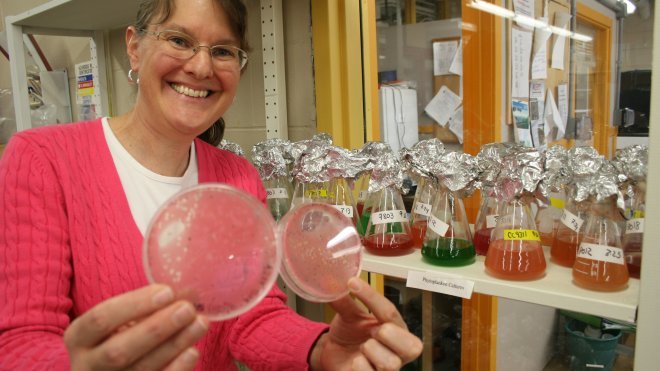RWU Marine Scientists to Collaborate on $3 Million NSF Grant Investigating Aquatic Viruses
Professors Marcia Marston and Koty Sharp join research team from four universities to study how marine and aquatic viruses impact microbes

BRISTOL, R.I. – Roger Williams University’s Marcia Marston and Koty Sharp are joining a research team from four universities that has received a $3 million grant to probe how viruses impact microbes critical to our lives, from producing oxygen to growing food.
K. Eric Wommack, deputy dean in the College of Agriculture and Natural Resources at the University of Delaware, will lead the team of marine scientists, which includes researchers from Roger Williams, the University of Nebraska-Lincoln, and the University of Hawaii-Manoa.
The four-year project was announced by the National Science Foundation’s Established Program to Stimulate Competitive Research (EPSCoR) on August 2. This collaboration is among eight projects across the U.S., totaling $41.7 million, that aim to build U.S. research capacity in understanding the relationship in organisms between their genes and their physical characteristics. Uncovering this genotype-to-phenotype relationship holds potential for improved crop yields, better prediction of human disease risk, and new drug therapies.
“Over the past several decades, scientists and engineers have made massive strides in decoding, amassing and storing genomic data,” said Denise Barnes, NSF EPSCoR head. “But understanding how genomics influence phenotype remains one of the more profound challenges in science. These awards lay the groundwork for closing some of the biggest gaps in biological knowledge and developing interdisciplinary teams needed to address the challenges.”
From water and soil to the human gut, you’ll find single-celled microbes – and viruses right alongside them. A virus will infect a microbe, hijack its machinery and begin replicating, eventually killing the host. But how these processes work within complex microbial communities is still largely a mystery.
RWU’s Marston and Sharp, along with their collaborators in Delaware, Nebraska and Hawaii, will focus research on viruses that infect phytoplankton – microscopic organisms that live in the salty ocean to freshwater lakes and conduct photosynthesis. Each researcher on the multi-institution team will examine a marine or aquatic virus that infects a different type of phytoplankton and from all types of bodies of water.
Drawing upon her 20-year collection of marine viruses sampled from Narragansett Bay, Marston’s research will analyze the genetic connection between marine viruses from local waters and their cyanobacteria hosts, called Synechococcus. Meanwhile, Sharp will train a spotlight on how viruses influence Astrangia poculata, a temperate species also known as Northern Star Coral that inhabit waters from Florida to Massachusetts.
“We will strive to make the link between genome sequences of viruses and their hosts, and how the genes of both organisms play a part in determining the outcome of viral-host interactions,” said Marston, a professor of biology at RWU who has received multiple NSF grants to conduct her research on marine viruses in Narragansett Bay. “As the host, phytoplankton form the base of the marine food web and are essentially what all other organisms rely on. It’s critical for us to understand the biology of these interactions because viruses infect and often kill their hosts, which can have repercussions for organisms higher up on the food web.”
Roger Williams University is one of only a few undergraduate-focused institutions to be included in the NSF’s EPSCoR award, and included in this project will be opportunities for many RWU undergraduate researchers to contribute to the research. While the partnering institutions will employ primarily post-doctoral fellows and graduate students in the research, Marston and Sharp will bring upwards of eight undergraduate students onto their teams, to conduct research and collaborate with researchers from all the universities, and present their research at national conferences.
“Professors Marston and Sharp’s new NSF collaborative grant is an outstanding example of how Roger Williams University promotes important research experiences not only for faculty, but also for undergraduate students,” RWU President Donald Farish said. “As a predominantly undergraduate institution, our faculty work closely with students on projects with critical contributions to local and national research topics.”
One of the goals of the multi-university collaboration will be to develop new technology to enable scientists to examine – in a droplet of water smaller than mist – how a single virus and a single microbial cell interact. They aim to make new tools and resources in microfluids technology available to the broader scientific community, Wommack says.
“Imagine doing a classic microbiology experiment with test tubes and culture plates. Our research would take all of those test tubes and cultures and reduce them down to a tiny droplet 100 times smaller than the diameter of a human hair,” said Wommack, who is an expert in environmental microbiology.
Operating under the principle that oil and water don’t mix, the interdisciplinary team will create devices the size of a microscope slide, equipped with tiny incubation chambers filled with oil, to isolate individual droplets of water injected with a syringe. Molds for these microfluidic devices will be fabricated in UD’s state-of-the-art Nanofabrication Facility for collaborators David Dunigan and Jim Van Etten at the University of Nebraska-Lincoln, Grieg Steward and Kyle Edwards at the University of Hawaii-Manoa, and Marston and Sharp at RWU.
The research team also will create the Viral Informatics Resource for Genome Organization (VIRGO).
“We have troves of genomic data on viruses,” Wommack said. “What’s limiting our work is that we don’t know the connections between the genes and what the viruses do biologically. How quickly do viruses infect a host? How long do they take to reproduce? What happens to the infected cell? Once we have that information in VIRGO, we can look at a viral community and make inferences about how unknown viral populations will behave.”